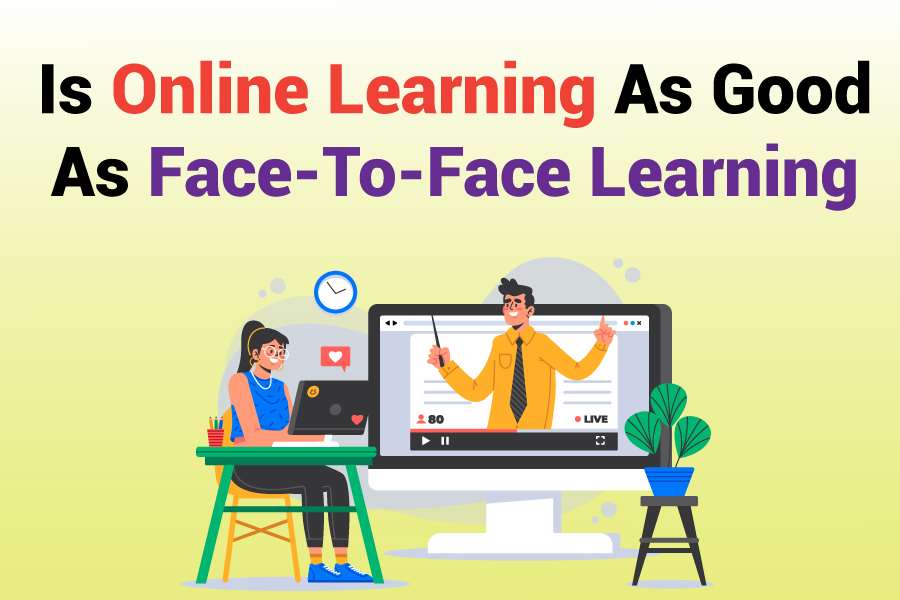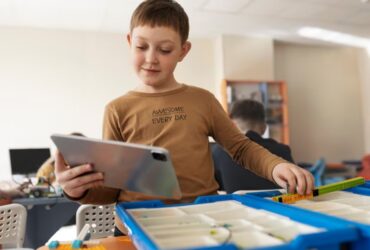The debate over whether online learning is as good as face-to-face learning centers on several key factors. Online learning offers unparalleled flexibility and accessibility, allowing students to learn from anywhere at their own pace. However, it may lack the immediate personal interaction and dynamic engagement found in traditional classroom settings. Face-to-face learning provides direct access to instructors and peers, fostering a collaborative environment that can enhance comprehension and retention. Both methods have their strengths: online learning can be highly adaptable with technological tools, while face-to-face education excels in real-time feedback and personal connection. Ultimately, the effectiveness of each approach depends on individual learning styles, preferences, and the specific context of the educational experience. Evaluating these aspects can help determine which mode of learning best meets your needs.
Overview Of Online And Face-To-Face Learning
In today’s educational landscape, the choice between online learning and face-to-face learning is more relevant than ever. Both methods offer unique benefits and challenges, and understanding their fundamental differences can help learners make informed decisions about their educational paths.
- Online Learning: Online learning, also known as e-learning or virtual education, involves accessing courses and educational materials through the Internet. This mode of learning has gained popularity due to its flexibility and convenience. Students can participate in courses from anywhere in the world, as long as they have an internet connection. This makes online learning an attractive option for individuals with busy schedules, those living in remote areas, or those seeking specialized courses not offered locally.
Key features of online learning include:
- Flexibility: Students can access course materials at any time, allowing them to learn at their own pace and fit their studies around other commitments.
- Diverse Resources: Online courses often utilize a variety of multimedia resources, such as videos, interactive quizzes, and discussion forums, enhancing the learning experience.
- Cost-Effectiveness: Many online programs are more affordable than traditional in-person education, reducing or eliminating costs associated with commuting, accommodation, and physical materials.
- Face-to-Face Learning: Face-to-face learning refers to traditional classroom-based education where students and instructors interact in person. This method has been the cornerstone of education for centuries and continues to be highly valued for its personal touch and immediate feedback.
Key characteristics of face-to-face learning include:
- Direct Interaction: Students benefit from immediate access to instructors and peers, facilitating spontaneous discussions, clarifications, and collaborative learning.
- Structured Environment: The fixed schedule and physical presence in a classroom create a structured learning environment that can help students stay focused and disciplined.
- Social and Networking Opportunities: Face-to-face settings provide opportunities for social interaction, networking, and building relationships that can be valuable both academically and professionally.
- Comparative Aspects: While online learning offers unparalleled flexibility and can accommodate diverse learning styles, it may lack the immediate personal engagement and hands-on experience that face-to-face learning provides. Conversely, face-to-face education offers a more immersive and interactive experience but may not be as accessible or adaptable as online learning.
Ultimately, the choice between online and face-to-face learning depends on individual preferences, learning styles, and specific needs. Many educational institutions are now adopting hybrid or blended models, combining the strengths of both approaches to offer a more comprehensive learning experience.
What Are The Key Differences Between Online Learning And Face-To-Face Learning?
When evaluating online learning versus face-to-face learning, several key differences emerge, each impacting the educational experience in distinct ways. Understanding these differences is crucial for students and educators alike to make the best choice for their educational needs and goals.
Accessibility and Flexibility: One of the most significant advantages of online learning is its unparalleled accessibility and flexibility. Students can access courses from any location, provided they have an internet connection. This flexibility allows learners to balance education with work, family, or other commitments, making it an ideal choice for those with busy schedules or those who live in remote areas. In contrast, face-to-face learning requires students to be physically present at scheduled times and locations, which can be restrictive for some individuals.
Interaction and Engagement: Face-to-face learning excels in fostering direct interaction and engagement. In a traditional classroom setting, students can engage in real-time discussions, ask questions, and receive immediate feedback from instructors and peers. This interactive environment can enhance understanding and retention of the material. Online learning platforms have made strides in creating interactive experiences through discussion boards, live webinars, and multimedia resources. However, they may still lack the immediacy and personal connection found in face-to-face interactions.
Learning Environment: The learning environment in face-to-face settings is typically structured and controlled, with dedicated spaces for learning, such as classrooms and labs. This environment can contribute to a focused and disciplined learning experience. Online learning, on the other hand, offers a more flexible environment where students can learn from home or any location of their choice. While this flexibility is beneficial, it can also lead to distractions and a less consistent learning environment.
Personalized Instruction: Face-to-face learning allows for real-time adjustments based on student responses and needs. Instructors can quickly gauge understanding, provide tailored feedback, and address individual challenges. Online learning platforms often use adaptive learning technologies to personalize content, but this approach may not always match the nuanced, responsive interaction available in physical classrooms.
Social Interaction: Social interaction is a notable difference between the two methods. Face-to-face learning provides ample opportunities for students to network, collaborate, and build relationships in person. This can be beneficial for developing communication skills and creating professional connections. Online learning platforms offer virtual interaction through forums and group activities, but these interactions may lack the depth and immediacy of face-to-face engagement.
Cost Considerations: Cost is another key factor in the comparison. Online learning programs often have lower tuition fees and eliminate costs related to commuting, accommodation, and physical materials. Face-to-face learning typically involves higher costs due to these additional expenses, although it may offer access to on-campus resources and facilities.
Technology and Resource Availability: Online learning heavily relies on technology and digital resources. Students need access to reliable internet and digital devices to fully engage with the course materials. Face-to-face learning, while also incorporating technology, is less dependent on digital tools for basic educational activities, relying more on physical textbooks and in-person instruction.
Learning Styles: Different students have varying learning preferences. Online learning can cater to self-directed learners who thrive in a flexible, independent environment. Face-to-face learning often benefits those who prefer structured, guided instruction and benefit from immediate feedback and interactive experiences.
Understanding these key differences can help students choose the learning method that best aligns with their personal needs, learning styles, and life circumstances.
How Can Students Decide Which Learning Method Is Right For Them?
Choosing the right learning method—whether online or face-to-face—depends on various personal and practical factors. Here’s a guide to help students decide which approach aligns best with their needs and preferences.
Assess Your Learning Style
Understanding your learning style is crucial in determining the best educational method for you. Some students thrive in interactive environments with immediate feedback and hands-on experiences, which face-to-face learning typically provides. If you learn best through direct interaction with instructors and peers and prefer structured schedules, traditional classroom settings might suit you better. On the other hand, if you are self-motivated, enjoy working independently, and prefer a flexible schedule, online learning could be more effective.
Consider Your Schedule and Flexibility
Flexibility is one of the most significant advantages of online learning. It allows you to access course materials and complete assignments at your convenience, which is ideal if you have a busy or unpredictable schedule. If you have work commitments, family responsibilities, or other obligations that make attending scheduled classes challenging, online learning offers a solution that can fit around your lifestyle. Face-to-face learning requires adherence to fixed schedules and locations, which may be less accommodating if you have a tight or irregular schedule.
Evaluate Technological Comfort and Resources
Online learning relies heavily on technology, so it’s important to assess your comfort level with digital tools and platforms. If you are tech-savvy and have access to reliable internet and necessary devices, online learning can be a seamless experience. However, if you struggle with technology or lack the necessary resources, face-to-face learning might be more suitable. Traditional classrooms provide physical resources and direct support, which can be advantageous if you prefer a more straightforward, less technology-dependent learning environment.
Think About Your Social and Networking Preferences
Face-to-face learning offers valuable opportunities for networking and social interaction. Building relationships with instructors and classmates can enhance your educational experience and open doors to career opportunities. If you value these interpersonal connections and thrive in a collaborative environment, in-person classes might be the better choice. Conversely, if you are comfortable with virtual interactions and can effectively network through online forums and social media, online learning can also provide networking opportunities, though in a different format.
Reflect on Your Self-Discipline and Motivation
Self-discipline is crucial for success in online learning. If you are highly motivated and can manage your time effectively without the structure of a traditional classroom, online education can be highly rewarding. However, if you find it challenging to stay on track without external accountability and regular supervision, face-to-face learning might offer the structure and motivation you need.
Ultimately, the right choice depends on your individual preferences, lifestyle, and learning needs. Evaluating these factors will help you make an informed decision that supports your academic and personal success.
The Wrapping Up
Whether online learning is as good as face-to-face learning depends on individual preferences, learning styles, and life circumstances. Online learning offers unparalleled flexibility and convenience, making it suitable for those with busy schedules or remote locations. Face-to-face learning, however, provides direct interaction and immediate feedback, which can enhance engagement and understanding. Both methods have their unique advantages and limitations. By evaluating personal needs, comfort with technology, and desired level of interaction, students can make an informed decision about which learning approach best aligns with their goals and circumstances.
FAQ
Can online learning replace classroom learning?
Online learning offers flexibility and accessibility but may lack the immediacy of personal interaction found in classroom settings. It can complement but not entirely replace traditional classroom learning for subjects requiring hands-on experiences and direct instructor engagement.
Is online learning the future of learning?
Online learning is increasingly shaping the future of education due to its flexibility and scalability. It’s likely to continue growing as a significant educational method, though it will coexist with traditional learning to provide a comprehensive learning experience.
Can online learning replace face-to-face learning?
While online learning provides convenience and adaptability, it cannot fully replace face-to-face learning, especially for subjects requiring direct interaction and hands-on experiences. Both methods will likely continue to coexist, each addressing different educational needs.













































Leave a Reply